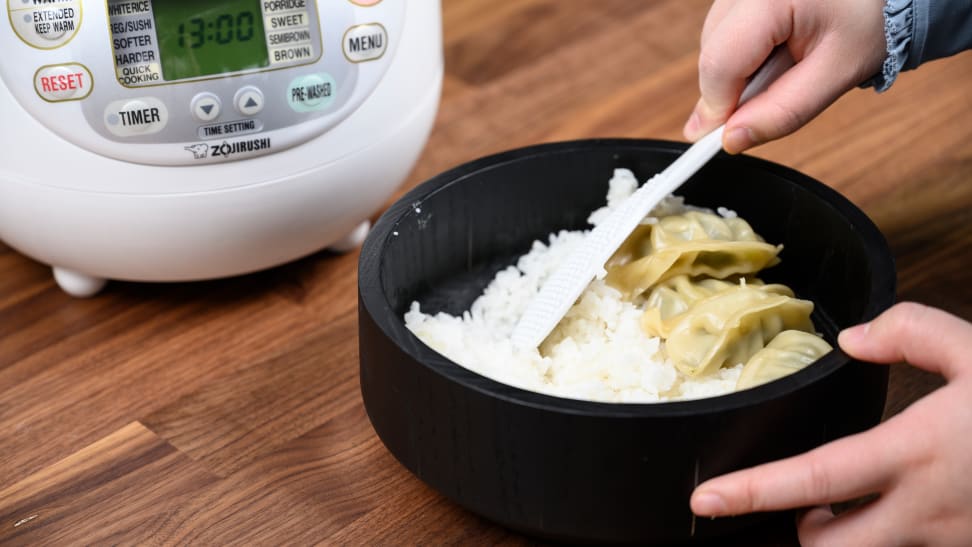 — Recommendations are independently chosen by Reviewed’s editors. Purchases you make through our links may earn us a commission.
— Recommendations are independently chosen by Reviewed’s editors. Purchases you make through our links may earn us a commission.Is there anyone who doesn’t like rice? It's a pantry staple. And while it’s completely possible to make great rice on the stove, doing so means hovering over the pot to ensure that your grains cook fully without burning. By using a rice cooker, like our new favorite Zojirushi Neuro Fuzzy Logic Rice Cooker and Warmer (available at Amazon for $129.99), you can avoid that hassle and focus on the rest of your meal. There's a reason these devices are a fixture in professional kitchens—they promise fluffy rice every time, and they do the work for you.
But which rice cookers fulfill their promise of perfection? If you're going to give up precious kitchen counter space for yet another gadget, it needs to be worthy. We tested 12 of the top rice cookers on the market to find out which ones are convenient, consistent, and—ultimately—can make that ideal bowl of rice.
These are the best rice cookers we tested ranked, in order:
- Zojirushi Neuro Fuzzy Logic Rice Cooker and Warmer
- Zojirushi NP-HCC10XH IH Rice Cooker
- Zojirushi Micom NL-BAC05SB Rice Cooker
- Panasonic One-Touch Fuzzy Logic SR-DF101 Rice Cooker
- Cuckoo CR-0631F Rice Cooker, 6cups
- Tiger Tacook JBX-B10U Rice Cooker 7, Midea MB-FS5017 Rice Cooker
- Tiger Micom JBV-A10U Rice Cooker
- Oster Rice Cooker with Steamer
- Hamilton Beach Rice & Hot Cereal Cooker
- Instant Pot Zest Plus Rice Cooker
- Dash Mini Rice Cooker
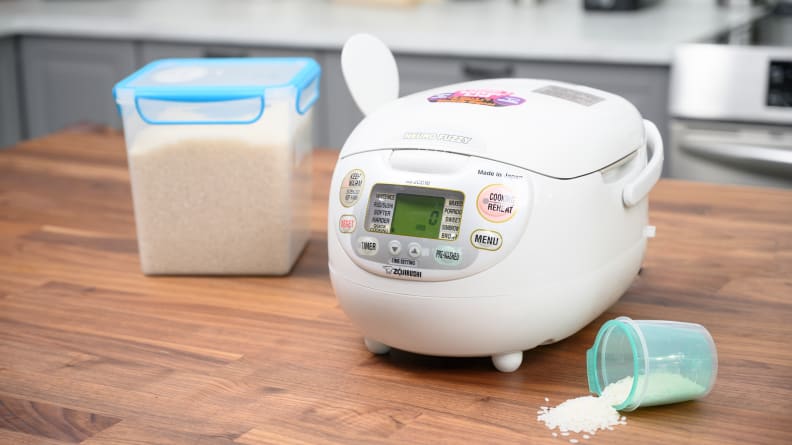

The Zojirushi Neuro Fuzzy Logic is the best rice cooker for most people.
After producing consistent and flavorful batches of brown rice, short grain white rice, and jasmine rice, this Zojirushi rice cooker came out on top. It’s the only rice cooker with side handles on the inner pan, which makes removing cooked rice easier and safer. It incorporates “fuzzy logic,” meaning the microchip in the rice cooker adjusts the temperature and cook time to make up for any mismeasured water to rice ratio.
The Zojirushi has convenient presets for most rice types that, when combined with the machine's "fuzzy logic," can turn out perfectly cooked brown rice, porridge, sushi rice and more. Its retractable power cord and plastic fold-down handle also make both transport and storage easy.
Although we love its presets, we found this cooker's control panel to be less than intuitive. To successfully select the proper menu option and start cooking, we had to hold the rice cooker still with one hand and press hard to get it to respond. However, this minor inconvenience didn't discourage us from loving this Zojirushi, as it consistently made the best quality rice in our testing.
Pros
-
High quality rice
-
Can cook different types of rice
-
Useful safety features
Cons
-
Expensive
-
Control panel isn’t intuitive
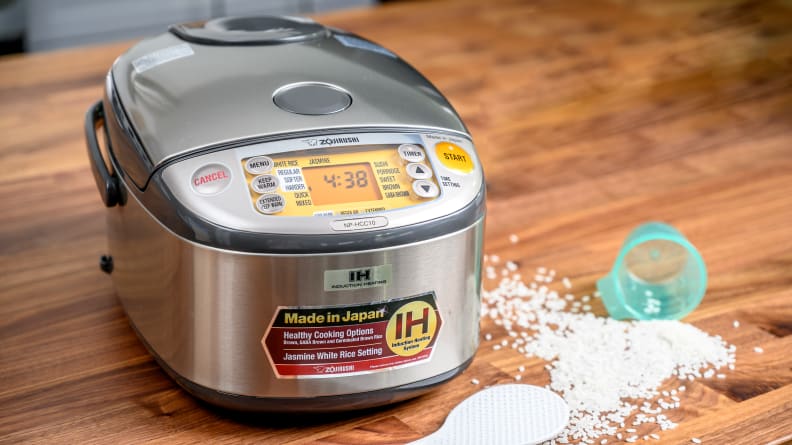

This rice cooker uses induction heating technology to cook rice evenly.
If you call yourself a rice snob, this is the tool for you. Equipped with induction heating technology, the Zojirushi Induction Rice Cooker is the next step up from fuzzy logic. Unlike electric rice cookers that heat solely from the bottom coil, this induction cooker heats the interior pan using a magnetic field, converting the entire pan into a heat source—which guarantees evenly cooked rice in every batch.
In our testing, we were impressed not only by how fluffy the brown and jasmine rice turned out, but also delighted by the slightly umami-flavored short grain white rice. Like other Zojirushi rice cookers, this machine allows you to adjust the texture of the rice to soft, medium or hard. It also opens smoothly without bouncing back, which is more than we can say for other cookers we tested. It makes cooking rice safer because the top lid won’t swing back and forth. The easy-to-press menu panel is also an upgrade from average rice cookers.
The rice cooker’s detachable inner lid makes for easy cleaning. We did find that some users have complaints about how long it takes to work—55 minutes for white rice and 60 minutes for brown rice (in comparison, the fastest rice cooker we tested takes about 30 minutes to cook a batch of short grain white rice). But every Zojirushi model we tested has a “Quick Cook” function for users who are in a rush to get their rice ready. The quality of the cooked rice is slightly inferior, but overall it’s not a bad feature to have. If you have the money, this is an excellent upgrade—it just doesn't balance features and price as well as our best overall.
Intrigued? Read our full review of the Zojirushi NP-HCC18XH rice cooker.
Pros
-
High quality rice
-
Intuitive control panel
Cons
-
Expensive
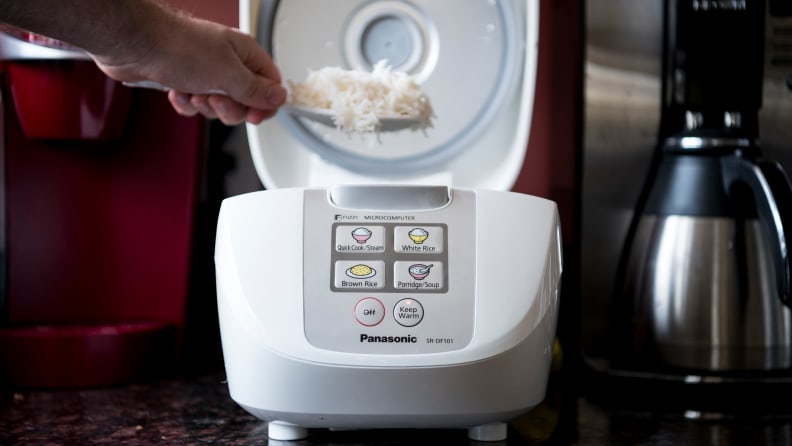

This Panasonic rice cooker is simple and inexpensive.
If consistency is your primary concern when making rice, the Panasonic Fuzzy Rice Cooker can get the job done. I used this rice cooker in my own home for eight years—the rice always came out fluffy yet soft and never overdone. Though this rice cooker takes longer to work than some might like (about 50 to 55 minutes), the final product is worth the wait.
Using this rice cooker is also incredibly easy. It has only four buttons, all clearly labeled, which makes cooking a simple process. Though this rice cooker made great rice and steamed fantastic dumplings with very little effort on our part, we didn’t like the design of the steam basket—it tended to leak into the rice if both sections were cooking simultaneously. For people who are interested in making just plain white rice on a regular basis and still want to stay on budget, this is a good choice.
Pros
-
Easy to use
-
Built to last
-
Budget-friendly
Cons
-
Messy steaming
-
Lack of features
How We Tested
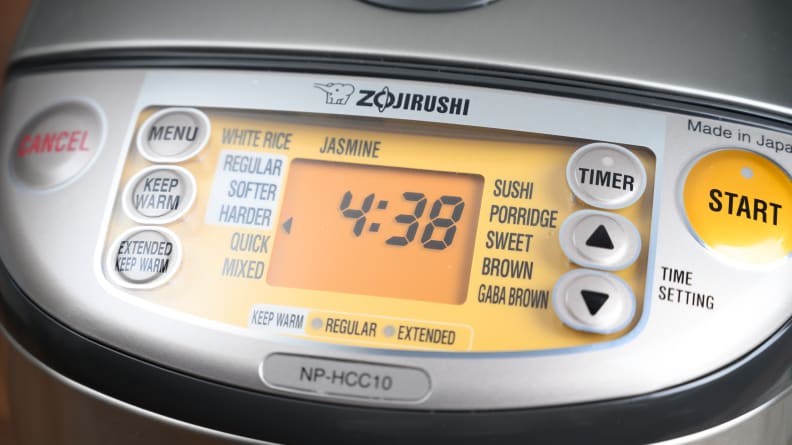
We cooked rice, steamed vegetables and dumplings, and compared features on every cooker.
The Tester
Bethany Kwoka tested the first batch of these rice cookers in 2018. As a home cook, she doesn’t have the time to babysit a pot of rice boiling over the stove while she fries up a batch of tofu and vegetables simultaneously, which led her to look for a rice cooker that could take care of that all-important task for her.
Valerie Li, Reviewed’s kitchen and cooking writer, continued Bethany’s work and tested a whole new batch of cookers in 2020. Growing up in an Asian household, she got used to seeing plain white rice in her meals three times a day, which helped shape her opinions about the most nuanced rice flavors. Her testing focused on the cooker’s abilities to cook a large variety of rice types considering the growing popularity of brown rice and other grains.
The Tests
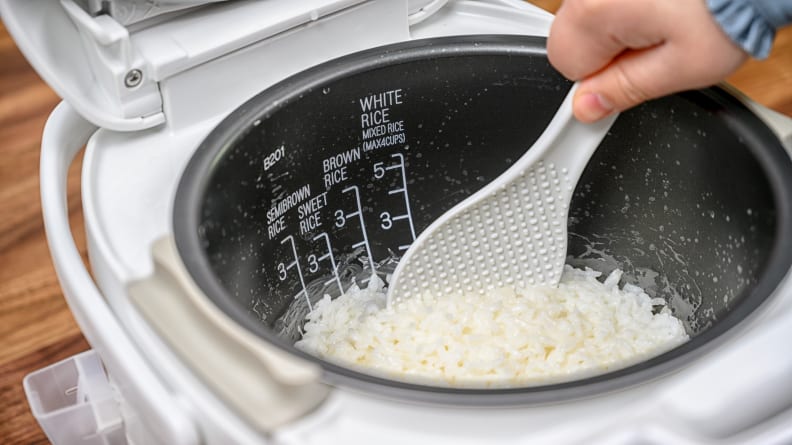
We focused our tests on cooking various types of grains.
Before we began testing, we spent hours scouring other reviews, various cooking sites, and manufacturers websites to find the best rice cookers worth their counter space. After first testing six rice cookers in 2018, we tested nine more rice cookers from both well-known and new-to-the-market brands in 2020 to find out which makes the best rice.
As brown and white rice cook quite differently, we wanted to see if each rice cooker could handle both a tougher, long grain brown rice and a short grain white rice. We also included long grain jasmine rice in the testing to see how each rice cooker performs with fluffy rice.
We also thought beyond rice, ultimately choosing to test the steaming baskets often included with rice cookers using frozen dumplings and fresh vegetables.
We tested each rice type twice to gauge consistency across tests and judged each cooker on its results. We also steamed Costco dumplings in each cooker, using the steaming basket provided.
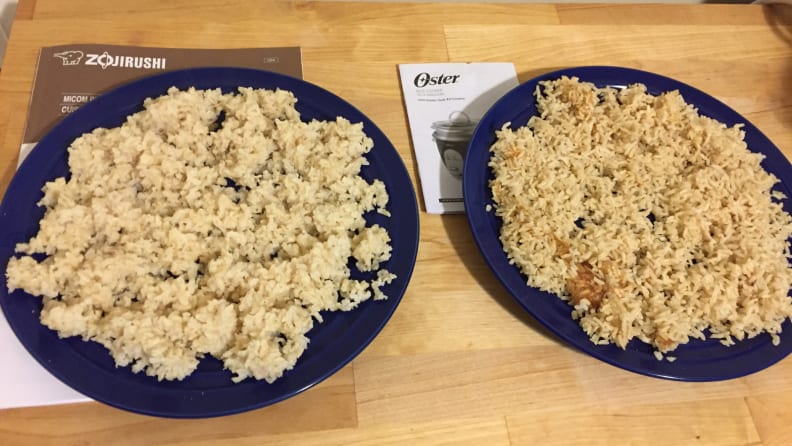
We compared the results from each rice cooker.
Alongside its cooking results, we considered how easy each rice cooker was to clean, whether it cooked rice consistently from one batch to the next, and whether it could handle cooking for both small and large groups. While we love having leftovers to make fried rice, we don’t want to be required to cook the same few dishes one after the other every time.
A final consideration was how much counter or cabinet space was required to house this new piece of kitchen gadgetry. Was it going to take over the entire apartment counter, or fit neatly next to the microwave? Can we tuck it away if we need the counter space to make holiday cookies or pies?
From all of this data, we determined our top contenders and noted various features and bugs others would benefit from knowing.
What You Need to Know About Rice Cookers
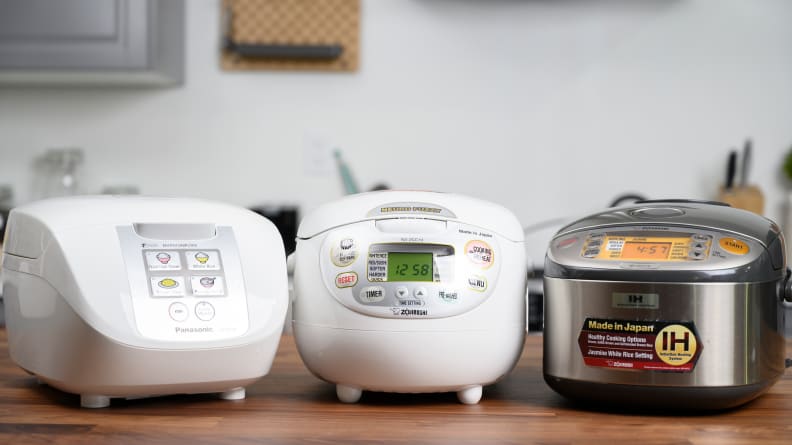
A rice cooker can be your best friend at dinner.
Rice cookers are absolutely phenomenal if you want to make a lot of rice without having to constantly monitor it over the stove. As an appliance that can take up some precious countertop space, a rice cooker has a lot to live up to and there are a lot of things to consider.
So before buying a rice cooker, ask yourself: How frequently do I cook rice? And how many features do I want from my rice cooker? Do I cook both white and brown rice frequently? Do I enjoy making sticky sushi rice? Would a warming function help me pull off those rice-based dinner parties I’m always planning? These questions are probably connected, and good to lay out before you make your purchase.
Some rice cookers, like the Oster we tested, have a single function controlled by a single lever. These are the most basic types. Others, like Panasonic, have multiple cooking functions and a “Keep Warm” option along with an inner bowl that tells you exactly how much rice and water to use for different types of rice. Both types are useful, but it’s good to know which you want and how much you want to spend.
In general, if you want perfect rice every time—regardless of which type of rice you’re cooking—then you’re probably better off getting a cooker that offers different settings for brown and white rice. You might also want to splurge for an induction rice cooker, but we’ll get to that in a bit.
How Do Rice Cookers Work?
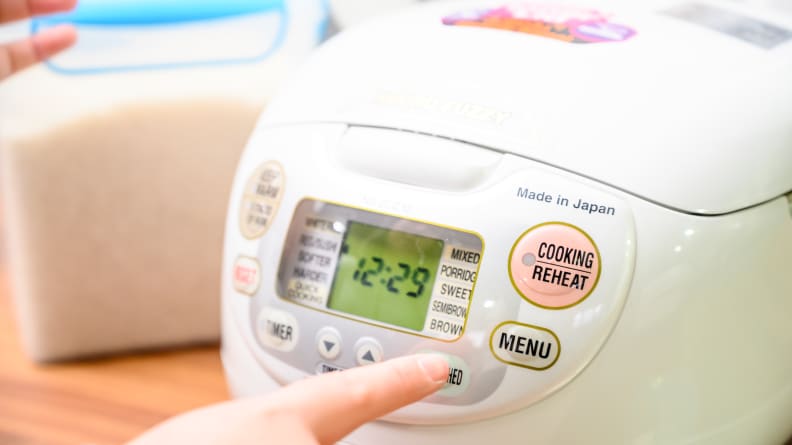
Rice cookers have smart sensors that let you know when the rice is done.
Before we dive into fuzzy logic, let’s look at how rice cookers work. It’s pretty simple. Rice cookers are constructed of five main parts: an insulated outer container, a non-stick removable inner pot, a selection of thermal sensors, a heating element, and a lid. Much like cooking rice on the stove, you just add uncooked rice and water to the inner pot, pop on the lid, and add heat. In this case though, the internal heating element boils the water while the thermal sensors ensure that heating stops once all of the water is absorbed.
These sensors are where the magic happens. On the stove, you have to judge your rice carefully—too much time cooking and the rice will absorb all of the water and start to burn. But pop the top to check too frequently and all of your steam will escape. With a rice cooker, the sensors know when the internal pot is heating up too much and can stop the cooking for you. (If it’s getting past water’s boiling point, 212°F, that means your rice has absorbed all of the available water and it's becoming overdone.)
Many rice cookers also have warming functions. These work by simply turning the cooking temperature way down after the pot reaches 212°F, rather than totally off. This keeps the rice warm without adding enough heat to burn your food.
What Is Fuzzy Logic?
A few of the higher-end rice cookers, such as Panasonic and Zojirushi, rely on what they call “fuzzy logic” to cook the perfect rice. It seems to work, but what does it do exactly? And how is it different from a typical rice cooker?
Jessika Toothman from HowStuffWorks explains it in more detail, but in brief: Fuzzy-logic rice cookers use computer chips that let the cooker make micro adjustments in real time. These programs allow more flexibility for cooking time and temperature, based on how the cooking process is going. So rather than always cook to 212°F and then switch off, a fuzzy logic cooker may change the temperature or cooking time depending on how fast the rice is absorbing water or what type of rice it knows you’re cooking. In essence, it’s reacting to your rice.
How Much Should I Spend on a Rice Cooker?
That depends on your budget. Think about the features you want and how much you’re willing to pay for them. If you know you’ll cook different types of rice, and rice quality is your highest concern, then we suggest splurging on a rice cooker with more features. Fuzzy logic and programming makes phenomenal rice and you can easily set the cooker to different types of rice that require different water and cooking times. Plus, the nicer cookers come with Keep Warm and other features. It’s fantastic if you’re like us and enjoy going back for seconds.
Another great feature that many people splurge on is induction heating, which changed the rice cooing game. Instead of having the heating element on the bottom of the cooker, induction heating technology allows each grain of rice to equally absorb the same amount of heat and water, making the rice quality exceptional.
Other Rice Cookers We Tested

Similar to other Zojirushi rice cookers we tested, the Zojirushi Micom rice cooker also incorporates advanced fuzzy logic to enhance the texture and flavor of cooked rice. Its triple-heating system with an extra large heater will turn uncooked brown, white, quinoa, and even steel cut oatmeal into perfectly cooked, fluffy grains. This Zojirushi also features a Cake preset that heats at a higher temperature for a slightly long time, ideal for baking a soft, Japanese cheesecake.
What knocked it down a few spots on our ranking is its capacity. Although it can handle three cups of uncooked rice, it’s smaller than other rice cookers we tested—one batch won’t feed a crowd.
Pros
-
Multiple useful features
-
Compact
-
Easy to clean
Cons
-
Small capacity

This Cuckoo cooker consistently nailed the three rice cooking tasks we threw at it. It was the fastest to steam high quality brown and white rice. However, it isn’t without flaws. The control panel is too complicated for new users who aren’t familiar with more advanced rice cookers and the manual isn’t helpful enough. When we looked at the safety features, we found the top lid to be too loose and it kept bouncing backwards upon opening. Unfortunately, the top steam vent also tends to bubble and leak rice water when cooking.
Pros
-
Quality rice
-
Quick steam
Cons
-
Unintuitive control pad
-
Bubbling protective steam vent

You may not be familiar with the Tiger brand, but they’re a household name in Japan. This rice cooker features presets for brown and white rice, as well as for porridge, slow cooking, and oatmeal. Thanks to its brilliant steam basket design, users can steam their food and cook rice at same time without worrying about the steamer leaking into the rice, which happens quite often with traditional steam baskets in rice cookers. However, this rice cooker takes up much more space than other rice cookers with similar features.
Pros
-
Presets for various types of rice
-
Synchro-cooking
-
Quality rice
Cons
-
Bulky
-
Control panel isn’t very intuitive

This Midea has the features of a high-end rice cooker—steam, slow cook, and presets for different types of rice—but with a much friendlier price tag. In the short grain white rice tests, the top part was cooked through, but the bottom had lightly browned spots, which means heating was uneven.
Unfortunately, the Midea didn’t excel in brown rice testing either, as the bottom got sticky and made it difficult to remove the residue bits. Like other high-end rice cookers, the Midea can alert you when the rice is done. Ultimately, it gets the job done but lacks the precision and sophistication needed to make quality rice.
Pros
-
Inexpensive
-
Multifunctional
Cons
-
Average rice
-
Bulky

We like this Tiger because of its simplicity. Measure the rice and water, close the lid, and hit the Start button. In half an hour or so, the rice will be ready. We also appreciate the “synchro-cooking” function, which means it can cook the rice and main dish at the same time. In the past, we tried steaming vegetables while cooking rice in the Panasonic, but the juices from vegetables kept on dripping through the holes in the steam basket, which gave the rice a funny taste. This Tiger steam basket is useful because the steam holes are on the sides, so there’s no leakage when two dishes are cooked at the same time.
However, we didn’t like how much space it takes on the countertop. It’s oddly tall and bulky, which also makes storing this cooker a challenge. Overall, it’s a rice cooker that can make decent white rice, but it doesn't have the useful presets seen in the more advanced rice cookers that we tested.
Pros
-
Useful steam basket
-
Good white rice quality
Cons
-
Large
-
Lack of presets for other types of grains


The Aroma Digital Rice Cooker packs a big punch for a small footprint. It looks sort of like a tiny Instant Pot, but with more focused features. And while it didn't make perfect rice every single time, it came pretty close (one test out of five came out spottily cooked). It's useful for steaming dumplings, too.
It might feel a tad rickety compared to higher-priced models, but the results are okay, the price is low, and the machine is downright easy to use. Our only significant qualm: there's no way to tell how much time is left before the rice is done. This is a minor annoyance if you’re only an occasional rice devotee, but if you make rice every day, you'll want to invest in a better model.
Pros
-
Useful features
-
Affordable
Cons
-
Bulky
-
Inconsistent rice quality
-
No timer
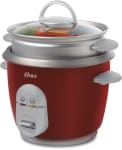
If you’re the type of person who throws all of your laundry—sheets, towels, fancy clothes, and jeans—into the wash together, this might be the rice cooker for you. Its super simple setup means tossing rice and water in, pushing a lever, and waiting for the lever to pop back up. You never really know if you’re making rice correctly, but you just have to trust it will work. Luckily, the rice always turned out okay during testing, and it can steam dumplings, though we had to guess when the dumplings were done.
This cooker is compact, comes with a steamer bowl, and won’t break the bank. If you want a simple, old-school rice cooker that does the job alright, then you may consider this Oster.
Pros
-
Easy setup
-
Steams dumplings
-
Compact
Cons
-
Average rice quality
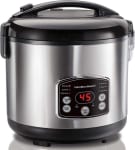
The Hamilton Beach rice cooker feels like a pressure cooker missing a bunch of functions. It's larger than a rice cooker really needs to be, and during testing it had trouble cooking a single cup of rice without overcooking the bottom in some areas. The rice it produced was okay, but not stellar, and had a tendency to stick to the bottom of the pot.
The one truly awesome thing about this rice cooker is that its steaming basket can double as a colander for rinsing your rice, which means that the Hamilton Beach is more of a “complete package” than some of the other cookers.
Pros
-
Steams dumplings and vegetables
Cons
-
Over-cooks rice
-
Bulky

At first glance, we almost mistook for an Instant Pot multicooker. It looks strikingly similar to a pressure cooker, except the presets on the control panel are different than on a typical one. The presets lean heavy on rice and grain cooking, but they still include slow cooking and other useful Instant Pot features.
However, this is the only rice cooker we tested that doesn’t have a detachable inner lid, which made cleaning difficult. In our testing, we found the rice tended to be mushy and overcooked, regardless of the grain size and type. Unless you're making quinoa, couscous, barley, and bulgur on a regular basis, we don't recommend buying this Instant Pot rice cooker.
Pros
-
Multifunctional
-
Affordable for what it does
Cons
-
Too bulky
-
Difficult to clean
-
Average rice

We were first intrigued by this Dash cooker’s size—it’s tiny and compact, which makes it appealing to students and young professionals who don’t have the space for a large rice cooker. However, we were disappointed by its performance in our testing. It claims to be able to cook two cups of uncooked rice, but when we cooked one cup of short grain white rice in our testing, there weren’t any safety measures to stop the water from overflowing when boiling. We had to unplug the rice cooker to stop the water from coming out, and it made a huge mess. Ultimately, we don’t recommend this rice cooker because how poorly it performed.
Pros
-
Straightforward
-
Compact
Cons
-
Flimsy
-
Mushy rice
